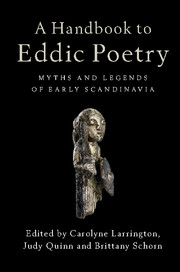Book contents
- Frontmatter
- Contents
- List of illustrations
- List of contributors
- Translations and abbreviations of the titles of eddic poems
- Introduction
- 1 The transmission and preservation of eddic poetry
- 2 Traditions of eddic scholarship
- 3 The editing of eddic poetry
- 4 The dating of eddic poetry
- 5 Eddic performance and eddic audiences
- 6 Eddic poetry and mythology
- 7 Eddic poetry and the religion of pre-Christian Scandinavia
- 8 Eddic poetry and heroic legend
- 9 Place names in eddic poetry
- 10 Eddic poetry and the imagery of stone monuments
- 11 Eddic poetry and archaeology
- 12 Eddic modes and genres
- 13 Eddic metres
- 14 Eddic style
- 15 Kennings and other forms of figurative language in eddic poetry
- 16 Alliterative lexical collocations in eddic poetry
- 17 The representation of gender in eddic poetry
- 18 The reception of eddic poetry
- Consolidated bibliography
- Index
1 - The transmission and preservation of eddic poetry
Published online by Cambridge University Press: 05 August 2016
- Frontmatter
- Contents
- List of illustrations
- List of contributors
- Translations and abbreviations of the titles of eddic poems
- Introduction
- 1 The transmission and preservation of eddic poetry
- 2 Traditions of eddic scholarship
- 3 The editing of eddic poetry
- 4 The dating of eddic poetry
- 5 Eddic performance and eddic audiences
- 6 Eddic poetry and mythology
- 7 Eddic poetry and the religion of pre-Christian Scandinavia
- 8 Eddic poetry and heroic legend
- 9 Place names in eddic poetry
- 10 Eddic poetry and the imagery of stone monuments
- 11 Eddic poetry and archaeology
- 12 Eddic modes and genres
- 13 Eddic metres
- 14 Eddic style
- 15 Kennings and other forms of figurative language in eddic poetry
- 16 Alliterative lexical collocations in eddic poetry
- 17 The representation of gender in eddic poetry
- 18 The reception of eddic poetry
- Consolidated bibliography
- Index
Summary
The period of oral composition, performance, and transmission
Prolegomenon
In the period before c.1000–1100, when the Scandinavian peoples began to adopt the technology of writing using the Roman alphabet, there is evidence from early runic inscriptions that they, along with other groups speaking Germanic languages, participated in the composition and recitation of alliterative poetry in what has been called the common Germanic verse-form (Lehmann 1956). In Old Norse scholarship, poetry in that common Germanic verse-form is usually referred to as eddic. We only know eddic poetry today from texts that were committed to writing, for the most part, in the thirteenth and fourteenth centuries, so access to Old Norse alliterative poetry from the pre-literate period can never be direct and many questions about its composition, performance, and transmission can never be definitively answered. However, written texts may give us important clues about the nature and significance of eddic poetry in the pre-literate period.
I begin this discussion by considering two passages from West Germanic alliterative poems that have come down to us in writing, but which may reasonably be considered to reflect attitudes to poetry in the common Germanic verse-form. The first of these is from the Old English poem Beowulf, whose precise date of original composition is not known, though it must antedate the unique manuscript, BL Cotton Vitellius A XV (c.1000), in which it has been recorded, perhaps by some two centuries (Fulk et al. 2008: clxiii–clxxiv). In lines 866b–75a of the poem, the Beowulf poet tells how there is great rejoicing after Beowulf has killed the monster Grendel, and one of the king's retainers (cyninges þegn) recites a poem about how the legendary hero Sigemund killed a dragon, as an indirect compliment to Beowulf for his killing of Grendel.
- Type
- Chapter
- Information
- A Handbook to Eddic PoetryMyths and Legends of Early Scandinavia, pp. 12 - 32Publisher: Cambridge University PressPrint publication year: 2016
- 4
- Cited by



